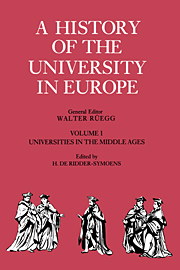Book contents
- Frontmatter
- Contents
- List of maps
- Contributors and editors
- Reader's guide
- Bibliographical abbreviations used in notes
- FOREWORD
- Acknowledgements
- PART I THEMES AND PATTERNS
- PART II STRUCTURES
- CHAPTER 3 RELATIONS WITH AUTHORITY
- CHAPTER 4 MANAGEMENT AND RESOURCES
- CHAPTER 5 TEACHERS
- PART III STUDENTS
- PART IV LEARNING
- THE FACULTY OF ARTS
- EPILOGUE
- Editors' note on the indexes
- Name index
- Geographical and subject index
CHAPTER 4 - MANAGEMENT AND RESOURCES
- Frontmatter
- Contents
- List of maps
- Contributors and editors
- Reader's guide
- Bibliographical abbreviations used in notes
- FOREWORD
- Acknowledgements
- PART I THEMES AND PATTERNS
- PART II STRUCTURES
- CHAPTER 3 RELATIONS WITH AUTHORITY
- CHAPTER 4 MANAGEMENT AND RESOURCES
- CHAPTER 5 TEACHERS
- PART III STUDENTS
- PART IV LEARNING
- THE FACULTY OF ARTS
- EPILOGUE
- Editors' note on the indexes
- Name index
- Geographical and subject index
Summary
General university structure
The history of the European university is the history of many universities, of which some eighty existed in the Middle Ages. They varied greatly in antiquity, permanence, and the quality of their teaching and research. Nevertheless, it is possible to detect some regularities, notably in the shaping influence of two archetypes, those of Bologna and Paris (see chapter 2), and in the use of the two main Latin terms which designated the medieval university: studium generale (or more simply studium) and universitas scholarium (or universitas magistrorum et scholarium). These reflect two features of its organization. A studium generale arose spontaneously or was founded by papal or imperial charter, and had the right to grant its alumni permission to teach at any university (licentia ubique docendi). The term universitas was of much wider scope. In law, it meant any type of corporation or community.
Like every corporate body in the Middle Ages the universities were, to some extent, distinguished by their privileges or, as they were then called, their ‘liberties and immunities’. The first and most important of these privileges was autonomy, that is, the university's recognized right to act as a corporate body in dealing with the outside world, to supervise the recruitment of its members, whether teachers or students, and to make its own regulations and enforce them by exercising some degree of internal jurisdiction. Other privileges, though, were enjoyed by individuals as members of the corporate body. Teachers and students alike enjoyed a personal status. This appeared in the twelfth century and took firm shape in the thirteenth. It owed much to canon law, supplemented by the Authentica Habita (1155), the scholar's statute.
- Type
- Chapter
- Information
- A History of the University in Europe , pp. 108 - 143Publisher: Cambridge University PressPrint publication year: 1991
- 3
- Cited by



